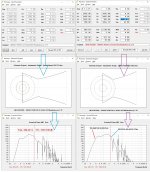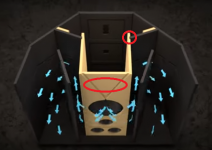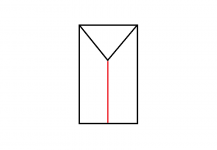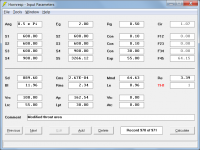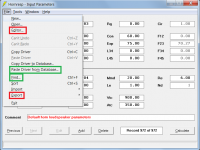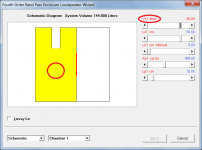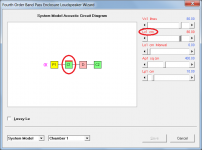Is the low pass behavior mainly due to the "chamber" formed by chamber depth times the baffle's area?
Not sure. What happens when the sliders specifying the chamber are adjusted in the Loudspeaker Wizard? Could that perhaps give an indication of what low pass effect if any, the chamber is having on the response?
Is it accurate to say one is a parallel vented horn while the other series ?
Again, not really sure. I guess it all depends on what is considered to be connected in parallel, and what is considered to be connected in series. Perhaps someone with more knowledge on such matters would care to comment further.
When the Input Parameters form has the focus, pressing Alt+F opens the File menu and pressing F again opens the Find record form.
Just noticed the potential for conflict with Paste Driver from Database (shortcut F). Shortcut will be changed to M in the next update.
maybe there isn't a lot of effect ? here's a one example - if not too confusing
Hi Freddy,
It doesn't really surprise me that the effect could be minimal. Firstly, the system does not have a clearly defined throat chamber and secondly, the rear chamber vents into the throat, which presumably could be deleterious to any filtering action.
I have now had time to look at the Roy Delgado New Jubilee video. What I found interesting was the V-shaped rebate groove in the main baffle, as highlighted in Attachment 1. This suggests to me that perhaps sloping panels are fitted between the baffle and the front panel of the horn, similar to the way that the joint circled in red is recessed.
Also, after further consideration I think that it would probably be better to calculate the throat area as detailed below (the throat area would really only be equal to the baffle area if the driver was firing directly in-line with the axis of the segment, which is not the case here).
Assuming that the V panels are present in the actual system, then the throat area becomes the length of the line shown in red in Attachment 2, multiplied by twice the distance between the baffle and the front panel.
Attachment 3 is an example design using the revised method of calculating throat area.
Kind regards,
David
Attachments
In the File Menu, Editor (shortcut E) will be renamed Data File Editor (shortcut D)
Changed my mind 🙂.
Editor to be retained, but shortcut changed from E to D:
Editor will become Editor
Hornresp Update 5310-210913
Hi Everyone,
CHANGE
The shortcut character for the Input Parameters form File menu "Editor" command has been changed from E to D to prevent it from conflicting with the "Export" command (also shortcut E). The shortcut character for the "Paste Driver from Database" command has been changed from F to M to prevent it from conflicting with the "Find" command (also shortcut F). Post #12415 refers.
BUG FIX
The Resize Wizard tool was not working correctly with Paraflex horns or with any horn system having stepped segments. This bug has now been fixed. My thanks to 'grindstone' for reporting the problem in Post #12415.
Kind regards,
David
Hi Everyone,
CHANGE
The shortcut character for the Input Parameters form File menu "Editor" command has been changed from E to D to prevent it from conflicting with the "Export" command (also shortcut E). The shortcut character for the "Paste Driver from Database" command has been changed from F to M to prevent it from conflicting with the "Find" command (also shortcut F). Post #12415 refers.
BUG FIX
The Resize Wizard tool was not working correctly with Paraflex horns or with any horn system having stepped segments. This bug has now been fixed. My thanks to 'grindstone' for reporting the problem in Post #12415.
Kind regards,
David
Attachments
HI David - I noticed that "V" too - but did not see the rebate into the baffle which would hold two boards.
Besides reducing throat area, does that also act like half a throat "splitter" ?
Other than ample port area for the new Jubilee, what might be the advantage of its baffle-throat vs a concentric arrangement like the horn-less "R-J" enclosure?
It can be assumed for a flagship design that they squeaked as much as they could.
Best wishes,
Freddy
PS - I'd like to do a K-type with internal tube. curved rflector and peaked EQ - but that may never happen. A good friend says to look at a compression driver's peak then set tube length as a 1/4 wave of that Z peak. I assume a slotted tube is always shorter than ifs physical length ... 😀 Gow might one determine some characteristics of a "K-tube"? - Would input impedance measurement driving one with a little cone speaker give some clues?
.
Besides reducing throat area, does that also act like half a throat "splitter" ?
Other than ample port area for the new Jubilee, what might be the advantage of its baffle-throat vs a concentric arrangement like the horn-less "R-J" enclosure?
It can be assumed for a flagship design that they squeaked as much as they could.
Best wishes,
Freddy
PS - I'd like to do a K-type with internal tube. curved rflector and peaked EQ - but that may never happen. A good friend says to look at a compression driver's peak then set tube length as a 1/4 wave of that Z peak. I assume a slotted tube is always shorter than ifs physical length ... 😀 Gow might one determine some characteristics of a "K-tube"? - Would input impedance measurement driving one with a little cone speaker give some clues?
.
Besides reducing throat area, does that also act like half a throat "splitter" ?
In effect, yes. It certainly more clearly defines the expansion rate of the first segment.
what might be the advantage of its baffle-throat vs a concentric arrangement like the horn-less "R-J" enclosure?
Not sure, but as you say, Roy Delgado and the Klipsch company must have had good reasons for adopting the design that they did. Quite sneaky really, using the bass reflex principle to directly augment the low frequency horn output at the horn throat itself, rather than having a separate direct radiating port output.
How might one determine some characteristics of a "K-tube"? - Would input impedance measurement driving one with a little cone speaker give some clues?
Possibly, but I suspect that it could be a bit tricky trying to identify meaningful characteristics from the electrical input impedance only.
I'll make a guess (poorly worded and probably wrong) that the "V" - by lessening throat area, allows a bit higher F reach until rolloff plus the V acts as a more defined waveguide for those upper frequencies than without that feature.
It would be interesting to know how much of this cabinet's development was empirical (in wood) vs simulation.
It would be interesting to know how much of this cabinet's development was empirical (in wood) vs simulation.
RE: 4th Order Bandpass Design Q's
Hello Everyone,
I have been using Hornresp to model a bandpass enclosure. I'm pretty satisfied with the modelling results however have a couple of queries which I cant find the answer to online and would appreciate some quick direction from those more adept.
1. I need to model the sub using two ports due to design constraints but cant do this with hornresp. Is there a quick formula to convert between single port diameter and length to two ports diameter and length to achieve the same bandpass results as modelled in Hornresp?
2. Just to confirm VC2 is the sealed chamber volume and LC2 is the height of the chamber. VC1 is the ported chamber and LC1 is the height of the chamber?
3. Is there any value in stuffing the chambers or ports to reduce unwanted resonances? How is this calculated and is the effect of stuffing similar to sealed / other ported subs? Does this help in tuning the box perfectly once the thing is built given how sensitive bandpass subs are to build anomalies affecting performance?
Thanks,
Rob
Hello Everyone,
I have been using Hornresp to model a bandpass enclosure. I'm pretty satisfied with the modelling results however have a couple of queries which I cant find the answer to online and would appreciate some quick direction from those more adept.
1. I need to model the sub using two ports due to design constraints but cant do this with hornresp. Is there a quick formula to convert between single port diameter and length to two ports diameter and length to achieve the same bandpass results as modelled in Hornresp?
2. Just to confirm VC2 is the sealed chamber volume and LC2 is the height of the chamber. VC1 is the ported chamber and LC1 is the height of the chamber?
3. Is there any value in stuffing the chambers or ports to reduce unwanted resonances? How is this calculated and is the effect of stuffing similar to sealed / other ported subs? Does this help in tuning the box perfectly once the thing is built given how sensitive bandpass subs are to build anomalies affecting performance?
Thanks,
Rob
Hi Rob,
Make the combined cross-sectional areas of the two port tubes equal to the cross-sectional area of the single port tube, with all the tubes having the same length. For example, if the single port tube has a cross-sectional area of 200 sq cm and a length of 25 cm, each of the two port tubes should have a cross-sectional area of 100 sq cm and a length of 25 cm.
Yes. This can be readily checked by clicking on the Vc1, Lc1, Vc2, Lc2 slider controls while viewing either the schematic diagram or system model.
I will leave this question for someone with practical experience in such matters, to answer.
Kind regards,
David
Is there a quick formula to convert between single port diameter and length to two ports diameter and length to achieve the same bandpass results as modelled in Hornresp?
Make the combined cross-sectional areas of the two port tubes equal to the cross-sectional area of the single port tube, with all the tubes having the same length. For example, if the single port tube has a cross-sectional area of 200 sq cm and a length of 25 cm, each of the two port tubes should have a cross-sectional area of 100 sq cm and a length of 25 cm.
Just to confirm VC2 is the sealed chamber volume and LC2 is the height of the chamber. VC1 is the ported chamber and LC1 is the height of the chamber?
Yes. This can be readily checked by clicking on the Vc1, Lc1, Vc2, Lc2 slider controls while viewing either the schematic diagram or system model.
Is there any value in stuffing the chambers or ports to reduce unwanted resonances?
I will leave this question for someone with practical experience in such matters, to answer.
Kind regards,
David
Attachments
Hi David,
Thank you for taking the time to clarify my queries on your great and very useful piece of software. I can also now see better how to navigate the GUI of Hornresp, it goes deeper than the interface might suggest 🙂
Kind Regards,
Rob
Thank you for taking the time to clarify my queries on your great and very useful piece of software. I can also now see better how to navigate the GUI of Hornresp, it goes deeper than the interface might suggest 🙂
Kind Regards,
Rob
Hornresp Update 5310-210917
Hi Everyone,
BUG FIX 1
The Loudspeaker Wizard menu command under the Tools menu was being disabled in all cases when a Hornresp record was imported. The menu command is now only disabled when a record that would not normally use the Wizard, is imported.
BUG FIX 2
The fatal run-time error message shown in the attachment was being generated when an attempt was made to export a record not in Edit mode, containing invalid data. This bug has now been fixed.
Kind regards,
David
Hi Everyone,
BUG FIX 1
The Loudspeaker Wizard menu command under the Tools menu was being disabled in all cases when a Hornresp record was imported. The menu command is now only disabled when a record that would not normally use the Wizard, is imported.
BUG FIX 2
The fatal run-time error message shown in the attachment was being generated when an attempt was made to export a record not in Edit mode, containing invalid data. This bug has now been fixed.
Kind regards,
David
Attachments
The fatal run-time error message shown in the attachment was being generated when an attempt was made to export a record not in Edit mode, containing invalid data.
I have just discovered that fixing the above bug has unfortunately created a new one. While the error message is no longer generated when an existing invalid record is exported, the following sequence of actions still causes the problem to occur:
1. Import a valid record.
2. Make a change to the imported record so that it becomes invalid.
3. Click the Previous button.
4. Save the changes made to the record.
5. Click the Next button.
6. Attempt to export the invalid record.
I will try to release an update tomorrow to hopefully fix the bug once and for all.
Hornresp Update 5310-210918
Hi Everyone,
BUG FIX
The bug reported in Post #12434 has now been fixed.
Kind regards,
David
Hi Everyone,
BUG FIX
The bug reported in Post #12434 has now been fixed.
Kind regards,
David
Hi Mark,
I won't rest until all the bugs are fixed. We seem to be down to the less obvious ones now, so hopefully we are slowly getting there.
Achieving perfection is never easy... 🙂.
It feels a bit that way at the moment, though 🙂.
Kind regards,
David
Oh the life of a bug swatter is a hard one!
I won't rest until all the bugs are fixed. We seem to be down to the less obvious ones now, so hopefully we are slowly getting there.
Achieving perfection is never easy... 🙂.
At least you are not doing it full time David.
It feels a bit that way at the moment, though 🙂.
Kind regards,
David
I will leave this question for someone with practical experience in such matters, to answer.
Kind regards,
David
Check out 1 of the Devastator (BP6P) builds on avsforum.com. I want to say the 4 JBL 12 build has measurements of various stuffing. Stuffing makes a difference.
Can anyone make sense about of the Schematic view in HornResp, I'm looking at a tractrix horn for example and I have no idea on how to intepret its length/mouth width etc...no mater where I put the mouse cursor I just get a notice showing a "dash" and "10cm" rofl! Plz be gentle.
- Home
- Loudspeakers
- Subwoofers
- Hornresp
